| 1965
CSS HPP 426W |
| This
truck is owned by Steve Bell. Steve writes that this was his father
in-law's truck and he purchased it new. Steve has finished his frame-off
resto and new photos have been addeded along with some background
on the truck written by Steve and his son Casey |
| <<<<
Previous Truck | Next Truck >>>> |
 1965
Second Series D100 Custom Sport Special 1965
Second Series D100 Custom Sport Special
426 Street Wedge
Owned by Steve & Carolyn Bell
1205 S. 276th Pl.
Des Moines, WA 98198
Restored by Steve and Casey Bell
Originally owned by Fred B. Lang (Carolyn’s Father)
November 18, 2003
Fred Lang owned a 1964 Dodge D100 CCS with a 413-ci engine.
When he found out about the new 65 _ model coming out with a
longer wheel base and a wider tailgate he knew it was what he
needed to haul his camper, boat and family of seven over the
Cascade mountains to their favorite camping spot.
Fred special ordered this truck from BBC Dodge in Seattle, Washington
early in 1965. The new model was being introduced in spring
of that year. He ordered the truck with every conceivable option
including the 426 street wedge engine. He didn’t know
it then, but he was ordering one of the rarest Dodge pickups
ever to be built. So few were built that they didn’t even
keep production numbers. Fred became very frustrated with the
delays and excuses on delivering his special Toreador Red pick-up.
Only later did we find out the real reasons for all of the delays.
His "baby" was delivered to BBC Dodge in August of
1965. Fred sold the 1964 413 to his brother.
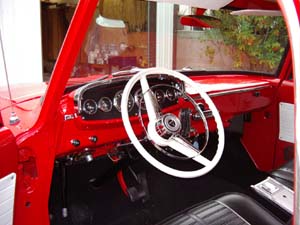 This
truck came to personify Fred Lang. Fred was a self made man
with a less than high school education. Educated in the school
of hard knocks Fred became one of the more successful homebuilders
in King County Washington. Everyone knew Fred was coming when
he drove up in his bright red, and fast, Dodge truck. He loved
to take it to Seattle International Raceways and compete in
the bracket races. He turned more than a few heads with ET’s
in the low 14’s and high 13’s. This
truck came to personify Fred Lang. Fred was a self made man
with a less than high school education. Educated in the school
of hard knocks Fred became one of the more successful homebuilders
in King County Washington. Everyone knew Fred was coming when
he drove up in his bright red, and fast, Dodge truck. He loved
to take it to Seattle International Raceways and compete in
the bracket races. He turned more than a few heads with ET’s
in the low 14’s and high 13’s.
The truck has always been special to our family. When I married
Carolyn I went to work for Fred. I used to drive the truck on
material and dump runs. Through the years the truck has always
been garaged. My son, Casey, admired the truck from the time
he was small. When he was a senior in high school he was allowed
to purchase the truck with the promise that he would not sell
it outside of the family. Casey was the one who started researching
the truck and found out how special it really was. When Casey
went off to college he found that and an old truck with a gas-guzzling
engine was not the most practical vehicle for him. I purchased
the truck from Casey and stored it for a couple of years until
I was ready to start working on it. I was finishing up a frame
off on a 1953 Chevy pickup that I had retrieved from my fathers
homestead in Montana.
 Casey
and I started taking the truck down in the fall of 2001. We
completely dismantled the truck down to the frame. Every mechanical
part on the truck has been rebuilt or restored. The 426 was
taken apart, balanced, blueprinted and reassembled with the
original heads and manifolds. The rear-end, transmission, power
steering, power brakes, tachometer and complete drive train
have been rebuilt. The truck was painted the original Toreador
Red color. All of the bright work was re-chromed. The interior
was restored to original condition. The black racing stripes
were applied. The only thing I could not bring myself to do
was to put the original style wheels and tires back on the truck.
It looks a lot better with the heritage American Racing Torque
Trust wheels. Casey
and I started taking the truck down in the fall of 2001. We
completely dismantled the truck down to the frame. Every mechanical
part on the truck has been rebuilt or restored. The 426 was
taken apart, balanced, blueprinted and reassembled with the
original heads and manifolds. The rear-end, transmission, power
steering, power brakes, tachometer and complete drive train
have been rebuilt. The truck was painted the original Toreador
Red color. All of the bright work was re-chromed. The interior
was restored to original condition. The black racing stripes
were applied. The only thing I could not bring myself to do
was to put the original style wheels and tires back on the truck.
It looks a lot better with the heritage American Racing Torque
Trust wheels.
 Back
to why it took so long to deliver the truck originally. The
426 high performance package on the newly re-designed 1965-second
series truck was an after thought. When the truck came down
the assembly line they actually had to take the truck off the
line and send it to a special shop. There they had to modify
the frame (they literally torched the transmission frame cross
member), build special motor mounts, build a new transmission
cross member, install torque rods for the 3:91 posi-traction
rear end, modify the cab to allow clearance for the exhaust
manifold (they just pounded out a dent in the firewall), install
the add on power steering and power brakes. I can’t verify
this, but I believe that after building our truck the Dodge
engineers said no more. In 1966 (which came out one month later
in September of 1965) you could buy the same truck but with
the 318 as the largest power plant available. Back
to why it took so long to deliver the truck originally. The
426 high performance package on the newly re-designed 1965-second
series truck was an after thought. When the truck came down
the assembly line they actually had to take the truck off the
line and send it to a special shop. There they had to modify
the frame (they literally torched the transmission frame cross
member), build special motor mounts, build a new transmission
cross member, install torque rods for the 3:91 posi-traction
rear end, modify the cab to allow clearance for the exhaust
manifold (they just pounded out a dent in the firewall), install
the add on power steering and power brakes. I can’t verify
this, but I believe that after building our truck the Dodge
engineers said no more. In 1966 (which came out one month later
in September of 1965) you could buy the same truck but with
the 318 as the largest power plant available.
 This
truck comes with all of the supporting tags and documentation
that verify it as an original 426 Custom Sport Special. We have
the SERT (Special Equipment Release Truck) sticker and the data
plate that says "SPECIAL" for the horsepower rating. This
truck comes with all of the supporting tags and documentation
that verify it as an original 426 Custom Sport Special. We have
the SERT (Special Equipment Release Truck) sticker and the data
plate that says "SPECIAL" for the horsepower rating.
Our goal was to complete the truck for Casey to drive his bride,
Andrea, away from their wedding on September 20, 2003. We finished
the truck one day before the wedding. Yes, he exceeded the speed
limit as he drove to the reception. I’ve promised my father-in-law
that he can take the truck down the strip next spring. You can
be sure that at 78 years old he’ll try his best to beat
his ET’s from the 60’s.
|
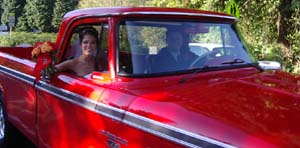 Casey
Bell 9:00 AM English 110 Casey
Bell 9:00 AM English 110
Documented Essay
The Rare Custom Sport Special
Take yourself back to the year 1964, imagine sitting in a luxury
automobile as you stomp on the gas pedal and are thrown back in
your seat. Well, up until 1964 this feeling could only be obtained
in certain cars, this is where the Custom Sport Special changed
the face of pickup trucks. What is a Custom Sport Special? It
is a rare Dodge Pickup that was produced from 1964 to 1967. This
truck is rare and was ahead of its time for four main reasons;
engine, exterior, interior, and the number of trucks produced.
This pickup was a revolutionary vehicle that is the most coveted
Dodge Pickup of all time.
The Custom Sport Special was offered in Dodge's D-100 and D-200
series pickups. The D-100 is a truck rated to withstand a load
of one-half ton, and the D-200 will hold a load of three-quarter
tons. D-100 and D-200 Dodge pickups are common, but when one has
the Custom Sport Special option package on it, it then becomes
special.
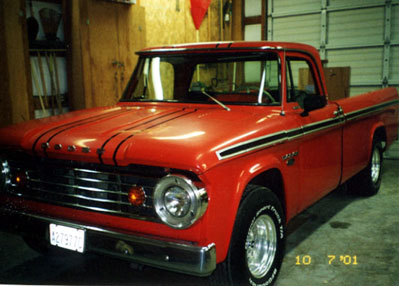 The
engine type that will be found in a Custom Sport Special is one
of three different engines: The
engine type that will be found in a Custom Sport Special is one
of three different engines:
Standard engine was the 225ci (cubic-inches), 140hp (horse-power)
slant six; the 318ci, 200hp V-8 was an option, but the greatest
excitement was derived from an optional high-performance package
consisting of a 426ci, 365hp V-8 which pumped out 470lb-ft (pounds-per-foot)
of torque thanks to a 10.3 to 1 compression ratio, four-barrel
carburetor, and a high lift, long duration camshaft. (Bunn 191)
The first two engines mentioned were available in all Dodge pickups
including the Custom Sport Special with a three-speed manual transmission,
a four-speed manual transmission, or a three speed automatic.
However, the high-performance 426ci engine was something reserved
only for the Custom Sport Special and was available only with
a three speed automatic transmission. The 426ci engine was produced
just in 1964 and 1965 because of the lack of sales. Though all
Custom Sport Special trucks are valuable, one containing a 426
is without a doubt the rarest.
Due to the tremendous power available with the 426 high-performance
package along with most owners of these trucks being lead footed
drivers, special exemptions had to be made on warranties for these
trucks (Mueller 92). The Chrysler Corporation assumed no responsibility
for repair due to extreme acceleration of the vehicle (93).
The most noticeable feature of a Custom Sport Special is its one
of a kind racing stripes:
Custom Sport Specials could be ordered in any Dodge truck standard
paint color. The four one-inch racing stripes were white on dark-colored
models and black on lighter ones. Besides the interior, these
stripes are the only thing to set this truck apart from other
Dodge trucks. (91)
 Along
with the striking paint scheme the truck exterior also includes
a bright chrome trim package. The paint and the trim package alone
sets the Custom Sport Special apart from any other Dodge truck. Along
with the striking paint scheme the truck exterior also includes
a bright chrome trim package. The paint and the trim package alone
sets the Custom Sport Special apart from any other Dodge truck.
Paint scheme and trim on the Custom Sport Special stayed pretty
much the same from 1964-1967, but there were a few changes made
to the exterior mid-way through 1965. The grill of the truck was
changed along with going to from four smaller headlights to two
bigger ones. The rear of the truck got new taillights and went
away from the chain system of opening the tailgate to a wider
tailgate with a more efficient chain-less system. A six-inch lengthening
of the bed of the truck from 122 inches to 128 inches was also
made. These changes made were not only made on the Custom Sport
Special they were made on all Dodge D-series pickups.
The interior options that came in a Custom Sport Special were
unlike anything anyone had every seen in a pickup truck. All Custom
Sport Specials were equipped standard with black vinyl bucket
seats from a Dodge Dart GT, with a console in between the seats
equipped with a cigarette lighter, ashtray, and map light (Brownell
136). Full carpet interior was also a feature found on all Custom
Sport Specials (136). These interior features that I've mentioned
had only been seen in cars up until the Custom Sport Special.
Nobody had seen such luxurious truck, yet it was still tuff and
durable like a pickup was expected to be.
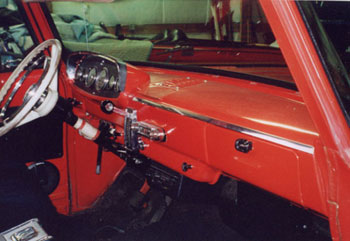 Along
with all of these upgraded features that came standard on the
Custom Sport Special, there were a few more extras added if you
owned a Custom Sport Special equipped with the 426 engine. Due
to the extra weight of the larger engine, power breaks and steering
were added, along with a heavy-duty instrument panel that included
a tachometer (RPM gauge). Along
with all of these upgraded features that came standard on the
Custom Sport Special, there were a few more extras added if you
owned a Custom Sport Special equipped with the 426 engine. Due
to the extra weight of the larger engine, power breaks and steering
were added, along with a heavy-duty instrument panel that included
a tachometer (RPM gauge).
All of the attributes of this truck that have been mentioned make
this truck very unique, but the thing that brings the rarity and
value is the number of these pickups that were produced. Because
of the low number of these trucks that came off the line Dodge
kept no production records on the pickup. This means there is
no way to ever tell for sure how many were made. Here are a few
expert opinions pertaining to the rarity and value of the truck;
"you can be assured that the Custom Sport Special especially
one with the 426 is by far the most valuable Dodge pickup ever
made…" (Wickstead). This is what Tom Brownell Author
of Dodge Pickups History and Restoration Guide 1918-1971 has to
say about the Custom Sport Special:
It is suspected that few were sold because virtually none exist
today. Or, it could be that they were driven into the ground.
If you stumble on one, especially a 426 powered Custom Sport Special,
buy it. It is a rare and valuable truck, which will not only appreciate,
but be a lot of fun to own and drive. (137)
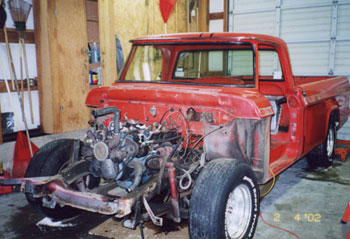 Clearly
the value and rarity of this Dodge Pickup is not in question. Clearly
the value and rarity of this Dodge Pickup is not in question.
Along with being a valuable truck, the Custom Sport Special truly
was a revolutionary vehicle. It was the first "sport truck"
ever produced. Up until the Custom Sport Special nobody ever thought
of a truck as any thing other than something to haul things with.
The Custom Sport Special was fun to drive because of its unmatched
performance, and it was equipped with many of the features found
in a luxurious car. Even today, every major American truck manufacturer
makes some version of a sport truck.
You may wonder why I have such and interest in the Custom Sport
Special; the reason is because my father and I own one. This 1965
Custom Sport Special came original with the uncommon 426 in it.
The truck is special to my family because my grandfather originally
bought this pickup when it was brand new in 1965. The truck is
in good shape right now, but my father and I have plans of taking
it back to its original condition.
The Custom Sport Special is the most valuable and rare Dodge pickup
ever made. It is not widely recognized for the value that it does
have because not many people know the history of the truck. Not
only should the truck be more recognized for its rarity, but it
should be looked upon as a vehicle that revolutionized the way
that Americans looked at the pickup truck. |
|
Bucket
seats and console -  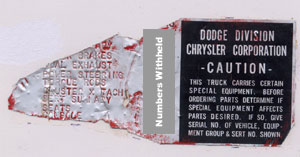 Notice
frame member is torched - Notice
frame member is torched -
this was done at factory and other 426 powered
examples have this done to them as well-   Rebuilt
426 Wedge Rebuilt
426 Wedge |
|
|
|
|
|
|
|
| <<<<
Previous Truck | Next Truck >>>> |

-
- Home - - Registry
- - What is a CSS? - - Register
your CSS - - Links - -
|
|